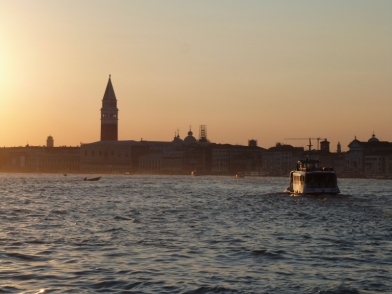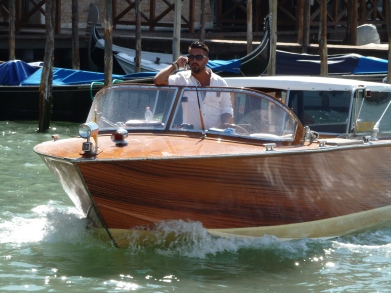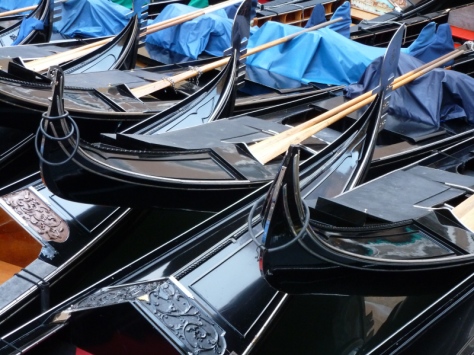Like any of us, the city of Venice includes at least three sides: the shiny face she wants to have seen; an unsavory underbelly; and a realistic working element. Getting to know the real Venice—like getting to know the real students or colleagues we work with every day—means making simultaneous sense of all three.
Venice has a reputation as a romantic haven, and with good reason. Its canals and lagoons reflect light at gorgeous angles at all times of day, from the first oranges and pinks of daybreak to the quiet twinkle of waterfront restaurants late night. Handsome gondolieri smoothly paddle their sweeping boats under bridges and around corners, disappearing and reappearing from canals and alleyways. Everywhere offers another wow. Striking statues, imposing towers and graceful domes all make for head-scratching views, and multiple museums attest to the city’s illustrious history as a center of culture and trade. Stepping into the splendor of St. Mark’s piazza at night, Melissa and I wondered if the place actually exists or if instead we had crossed into some Disney-like façade, installed to make us think we were actually in Venice.[1]
It’s also a glitzy city. High-end stores like Chanel and Giorgio Armani keep hives of attendants ready to serve the whims of the few customers who get inside while others wait their turn on busy sidestreets outside. Tanned and muscular water taxi drivers maneuver the canals with confidence from behind dark glasses, wrist on steering wheel, cell phone to ear. Gilded ceilings and ornate paintings in the dozens of palazzi suggest that wealth has blessed the city for centuries. If the joint’s good enough for Johnny Depp, Angelina Jolie, and James Bonds old and new, it should work for any other high roller as well.
A seedy underside cuts through the illusion on any extended stay, however. For one, the place throbs with tourists and you’ll likely wait in line for hours at the most desirable sites.[2] Ticky-tack vendors approach for black-market sales. Small alleyways clogged with pedestrian traffic come to seem more claustrophobic than romantic. A half-hour gondola ride loses appeal when it costs more than 100 euros and lags between other slow-moving boats laden with camera-toters, all of whom seem more interested in capturing the beauty than experiencing it.
Hordes of people create all kinds of waste too. At the end of each night, Venice wobbles like it’s overcoming a hangover, trash overflowing into canals and smells of urine wafting around each corner. After a while, the tall and dark passageways morph from friendly fascination to foreboding funhouse, each seemingly identical twist and turn returning to the same spot or dead-ending into a backwater canal. One comes to question if there’s any there there: is Venice just a tourist-economy parasite living off a historical host? Are there more than ghosts? Again, is it all just an illusion?
Behind the shine and the slime, though, one also comes to see the grit of the city. Real people do real work to keep the island afloat. Early morning boatloads of city employees arrive to sweep streets and clear canals, restoring the Venetian glow before most tourists arise. Delivery men hoist cases of fresh drinking water from boat to hotelside dock, while others take back loads of laundry for cleaning on the mainland.
In neighborhoods tucked neatly away from hustle and bustle, mothers sing to their babies at breakfast and fathers struggle to keep their sons more interested in gondolas than in GameBoys. Ex-pats from other places come to invest in restaurants or offer translation services while local-borns find work that allows them to pay the bills.[3] People grow up, get married, and die in Venice. Life goes on.
As with Venice, it’s easy to get glassy-eyed from the greatness we see in those around us. A confident student might offer a compelling presentation or make an intoxicating connection early in the term. A co-performer might draw a huge laugh with her lightning wit. A first date’s smile could keep us up at night wondering what could come around the corner. So much excitement. So much possibility.
At the same time, it’s also easy to be repelled by what’s distasteful. We may see that same student bully a classmate or blow off a week’s worth of homework. That improvisor might win her laughs at the expense of stagemates. And the thrilling buzz of beginnings might lead to a rash of painful stings. Lock into this second vision of others and we reflexively push them away. We’re left alone.
All the while, we each muddle through the real work of everyday life. The student’s successes and failures likely have less to do with our teaching and more to do with their sleep patterns, hormonal surgings, and support—or lack of it—they have at home. Maybe our troupe member is struggling to heal from an injury or to make up for a misstep with her boss. Under more natural rhythms, the potential partner might prove an unflinching observer of what the relationship brings forward. The reality inevitably proves more complex—and more mundane—than our first dramas of light and dark.
If I could only choose one of these channels to follow, I’d most certainly take the third. I love the small kindnesses that enable people and places to keep going. I want to know what goes on behind the scenes. These stories consistently seem the most memorable, most compelling, most connection-building.
That said, the fullest truth always lies in the interweaving relationship between all three. Venice is her romantic glamour, for sure. She is also her ugly underside. And she is the everyday work that builds her foundation. The three canals braid together into one larger stream, each a changing component of the “real” city. And it’s the same with us. Our persona can pull others in. Our shadow can turn them away. And our everyday consciousness does what needs to be done. All three make up the larger Self. All three have a role to play.
Given these insights, I continue to ask: how can I serve and activate this wholeness in students, in colleagues, and in myself? What methods or invitations offer a wide-ranging welcome? How do I keep my eyes trained on the wider wholeness rather than falling for the illusion of focusing on one narrower part? I get the sense that each sabbatical step I take will bring me closer to these answers. Those steps will also likely lead to more questions. If we’re working for wholeness, that’s just fine.
[1] I’ve had this feeling one other time, when I first saw Yosemite National Park in California. Each vista seemed grander and more gorgeous than the next, glowing with an unforeseeable panoramic beauty. My jaw ached from so many drops.
[2] One stat we read suggested that 80% of Venice’s visitors come for fewer than 8 hours (think cruise boats stopping for some on-shore time). Of those, fewer than 10% spend more than 15 euros during their time in the city. No wonder the municipality is considering limiting the numbers who come in each day.
[3] All those boats need building, for example: each gondola takes 6 months and more than 300 pieces to construct.








Meaninful, insightful, articulate, artistic… very nice piece. I hope lots of educators (everyone is an educator) see this.
J